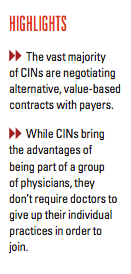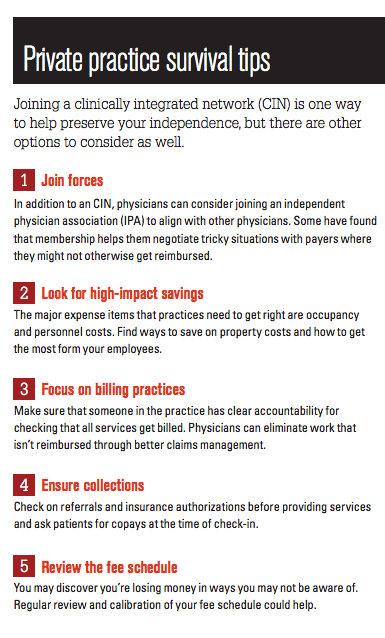Article
Understanding clinically integrated networks
Author(s):
Joining forces with other physicians to thrive is necessary, and a clinically integrated network may be a route to consider

With physicians facing pressure from all sides to deliver better quality care at a lower cost, clinically integrated networks (CINs) offer new approaches with some unique features compared with other types of physicians’ groups.
Run by physicians, sometimes with sponsorship by a hospital, CINs are networks of providers who use shared electronic health record (EHR) systems to track which methods of clinical care deliver the best bang for the healthcare buck among the patient population-and share that information so all can benefit.
There are about 500 CINs in the U.S., according to a 2015 white paper by Caradigm, a healthcare analytics company based in Bellevue, Washington. Their numbers have grown since 1996, when the Federal Trade Commission provided guidance on its anti-trust policies regarding healthcare organizations, so affiliated healthcare organizations could avoid anti-trust violations.
When it comes to CINs, “the keywords are efficiency, and low-cost but high-quality care,” says Glenn P. Prives, JD, an attorney at McElroy, Deutsch, Mulvaney & Carpenter, LLP in Morristown, New Jersey who has worked with CINs.
The vast majority of CINs are negotiating alternative, value-based contracts with payers, says Tomas Mikuckis, a Boston, Massachusetts-based principal in the health sciences group of Oliver Wyman, an international management consultancy based in New York City.
“Generally what we see are things like shared savings-or shared risk, for the more sophisticated ones,” he says. “Additionally, we have seen CINs/[accountable care organizations (ACOs)] frequently be a chassis for narrow network partnerships and product partnerships with commercial payers, especially in Medicare Advantage and the individual exchange market.”

And though CINs bring the advantages of being part of a group of physicians, they don’t require doctors to give up their individual practices-though there are some CINs consisting of employed physicians. “This is not a merger,” says Prives. “This is not a hospital buying practices. You stay in your own practices, just like you did before, but you are going to share best practices with the group.”
It is important, however, to realize that CINs are a legal structure, not a payment model, notes Neil Kirschner, PhD, senior associate, health policy and regulatory affairs with the American College of Physicians. Their structure enables physicians to team up in negotiations with payers without violating the Stark anti-trust laws. “The legal structure allows them to provide more integrated and coordinated care and do some more bargaining with payers, which would not be allowed from independent providers,” he says.
Physician incentives
Many independent physicians like CINs because, in addition to the shared learning, the organizations bring some financial advantages.
The CIN negotiates on physicians’ behalf with payers and often can get better reimbursement rates. “The joint contracting aspect is always going to be attractive,” says Prives. That can often outweigh any financial commitment the physicians must make. Members often get bonuses for achieving a CIN’s goals as well.
“It’s case by case, in terms of the bonuses they give,” says Kirschner. “Often, these CINs contract with payers, and the way the CIN pays its providers or share the contractual payments varies.”
Prives says bonuses may not be limited to a percentage of savings and may also include compensation for achieving certain quality metrics.
In most cases, physicians will learn of the bonus formula before signing a participating provider agreement with the CIN. For physicians who are also owners of the CIN entity and thus eligible to share in any distributions made by the CIN, the method of distribution will be set forth in the governing document for the entity. For instance, if the entity is a limited liability company, this will be the operating agreement, Prives says.
CINs must balance the need to incentivize physicians against the financial demands of maintaining the CIN. “One of the key balance points is the investment in common infrastructures to support more efficient, effective and reliable clinical/population health activities,” says Joe Kimura, MD, deputy chief medical officer of Atrius Health, a nonprofit, community-based physician group in Newton, Massachusetts. Hence, the CIN must balance the future facing strategic investments with annual bonus payments.
Network challenges
Of course, CINs are not a cure-all for the complex pressures facing physicians. Membership can require a significant commitment from doctors.

For one thing, they need to agree with the goals of the CIN, note experts and physicians. The CIN likely will be evaluating the performance of the entire group in achieving those goals-as well as individual doctors’ performance metrics.
For some physicians accustomed to independence, having their performance monitored by the CIN isn’t easy. “It makes independent doctors very nervous,” says David Birdsall, MD, vice president of CEP America, a California-based consulting firm for hospitals.
“Independent physicians are people who are very confident in their abilities and have a vision of their practice. They feel if they are affiliated with or in a network that is constraining, people now will tell them what to do or have expectations of them, and try to force different practices on them.”
Membership in a CIN also requires a genuine willingness to accept new technology, since physicians must be willing to use EHRs to share patient data. Doctors who have been putting off making the transition to EHRs will need to embrace them to participate in a CIN. “Some could get left out, although those who are less tech-savvy could use this as an opportunity to get up to speed,” says Prives.

And even when members of a CIN are all rowing in the same direction, the group’s success in improving patient care sometimes depends on factors not entirely in the physicians’ control. For example, if the CIN is focused on lowering hospital readmission rates, the CIN and the admitting hospitals its members use need to be focused on that goal, notes Jay Zdunek, DO, senior medical director of primary care at Austin Regional Clinic in Austin, Texas.
“There’s a whole lot of coordination of care that has to take place to safely discharge a patient home and make sure they are not readmitted in a 30-day period,” says Zdunek.
CIN vs. ACO vs. PCMH
Despite the challenges of running CINs, the timing may be right for more physicians to join them, say experts. Healthcare reform and changes in Medicare have helped to spur the wave of CINs and other collaborations among physicians, hospital systems and other healthcare providers, says Mikuckis.
With groups such as accountable care organizations (ACOs) and patient-centered medical homes (PCMHs) working toward similar goals but organized differently, CINs fulfill some physicians’ wishes that the others don’t, some say.
ACOs are payment models in which groups of medical providers band together to deliver coordinated care to Medicare patients-with the goal of eliminating unnecessary and duplicated services. While ACOs share CINs’ emphasis on better care and more value, they’re run differently.
Unlike many ACOs, which tend to be dominated by hospitals, CINs might have a hospital sponsor, but the governance is strongly physician-led, Prives says.
In some cases, though, CINs are actually part of ACOs. Joining the network can help providers who treat Medicare patients collect incentives for providers able to achieve measures such as improved quality of care, meaningful use of EHRs, and better use of resources.
A PCMH is a payment model where there are groups of physicians who aim to improve the coordination and patient communication in primary care practices have some key differences from CINs, too. Among them is the fact that they don’t negotiate with insurance companies for their members.
“The patient-centered medical homes are smaller,” says Prives. “Usually you have the payer’s contract with individual group practices.”
The smart practice
The lure of what might be described as Big Data is another reason for physicians to join CINs. By allowing a look at how various treatment approaches are working with a larger patient population than in one individual medical practice, they can make it easier for physicians to gain insights that might be unavailable in an individual practice.
“Most physicians are getting accustomed to looking at their quality data. What’s changed [with CINs] is in addition to working with the patients in front of you, you are reaching out to the entire population,” says internal medicine physician Karen Cabell, DO, chief quality and patient safety officer at Billings Clinic, a CIN in Billings, Montana, a physician-led, integrated multi-specialty group practice with a 304-bed hospital with 400 employed physicians and advanced practitioners.
CINs can also provide physicians with information they might not otherwise get from patients for months, allowing doctors to be more proactive. For example, some CINs now notify primary care physicians if a patient has been admitted to the emergency department after a car accident, which makes it easier for the physician’s office to follow up with a patient.
CINs may also offer ancillary services that enable physicians to be more proactive with patients-such as grocery shopping with them to find healthy food-but would be unaffordable for a solo practitioner to offer. And a CIN may assign personnel to do outreach as often as weekly to higher-risk patients to make sure the physician finds out early if a patient decides to cease taking a needed medication.
“I think the fear is always that as a primary care doctor, I’m missing something-a piece of important information about my patients-and I hear about it in six months, when my patient comes to me,” says Kimura. Atrius is a member of the Council of Accountable Physician Practices, a group of physician-led medical groups and health systems focused on the delivery of patient-centered care using integrated services.
Some CINs also offer disease management registries, for heart disease, diabetes, asthma and other chronic conditions.
Making the best use of such elements requires coordination, of course. Primary care practices will need to give considerable attention to the full delivery system for care, and how factors like accountability cascade up and down an organization, notes Kimura, adding, “These are areas that require thought and projecting into the future,” he says.





